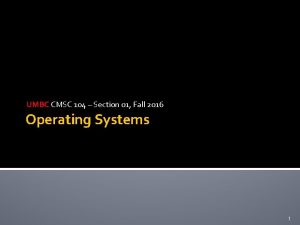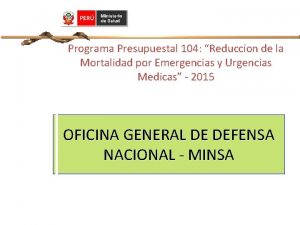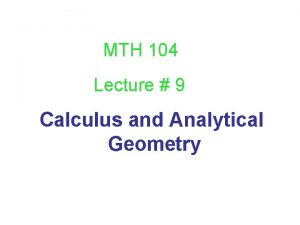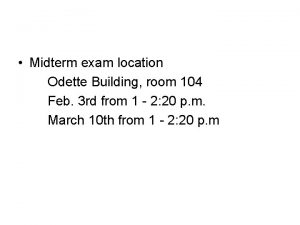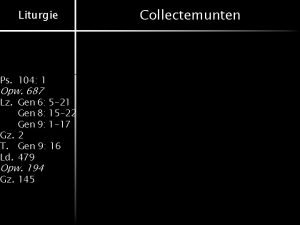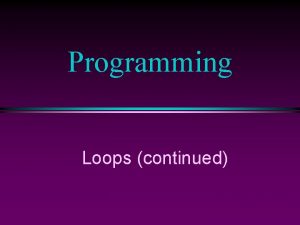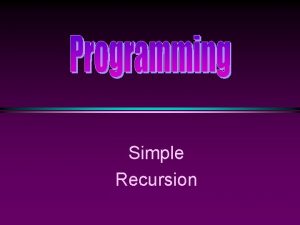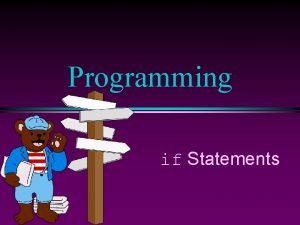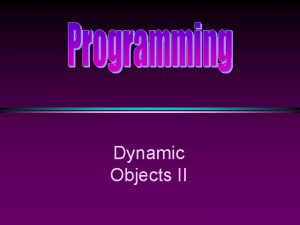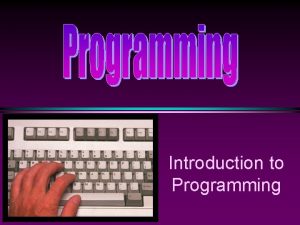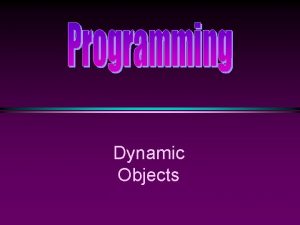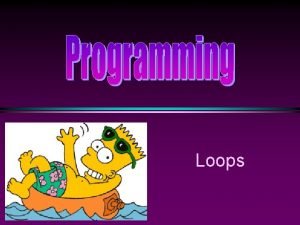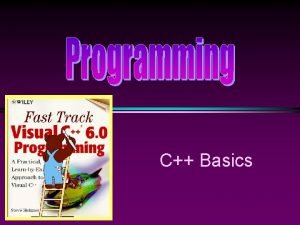Functions COMP 104 Lecture 13 Slide 2 Review













- Slides: 13

Functions

COMP 104 Lecture 13 / Slide 2 Review of Array: Bubble Sort http: //www. cs. brockport. edu/cs/java/apps/sorters/bubblesort. html List[0], List[1], … List[n-2], List[n-1] One pass to “sink” the largest number to the bottom of the list for (j=0; j<n-1; j++) { if (List[j] > List[j+1]) swap(List[j], List[j+1]); }

COMP 104 Lecture 13 / Slide 3 Review of Array: bubble Sort http: //www. cs. brockport. edu/cs/java/apps/sorters/bubblesort. html N passes to “sink” the currently largest number for (i=n; i>=1; i--) { for (j=0; j<i-1; j++) { if (List[j] > List[j+1]) swap(List[j], List[j+1]); } function (subprogram) }

COMP 104 Lecture 13 / Slide 4 Introduction to Functions *A complex problem is often easier to solve by dividing it into several smaller parts, each of which can be solved by itself. *This is called top-down programming. *These parts are called functions in C++ (also sometimes called subprograms). *main() then executes these functions so that the original problem is solved.

COMP 104 Lecture 13 / Slide 5 Advantages of Functions *Functions separate the concept (what is done) from the implementation (how it is done). *Functions make programs easier to understand. *Functions make programs easier to modify. *Functions can be called several times in the same program, allowing the code to be reused.

COMP 104 Lecture 13 / Slide 6 Function Input and Output Parameters Function f(x, y) = g abs(-5) = 5 Result

COMP 104 Lecture 13 / Slide 7 C++ Functions *C++ allows the use of both internal (user-defined) and external functions. *External functions (e. g. , cin, cout, rand, etc. ) are usually grouped into specialized libraries (e. g. , iostream, cstdlib, cmath, etc. )

COMP 104 Lecture 13 / Slide 8 Mathematical Functions * #include * * * * <cmath> double log(double x) natural logarithm double log 10(double x) base 10 logarithm double exp(double x) e to the power x double pow(double x, double y) x to the power y double sqrt(double x) positive square root of x double ceil(double x) smallest integer not less than x double floor(double x) largest integer not greater than x double sin(double x), cos(double x), tan(double x), etc. . .

COMP 104 Lecture 13 / Slide 9 Functions in a Program * C++ programs usually have the following form: // // include statements function prototypes main() function user-defined functions

COMP 104 Lecture 13 / Slide 10 Absolute Value #include <iostream> using namespace std; int absolute (int); // function prototype for absolute() int main(){ int x, y, diff; cout << "Enter two integers (separated by a blank): "; cin >> x >> y; diff = absolute( x - y); cout << "The absolute difference between " << x << " and " << y << " is: " << diff << endl; return 0; } // Define a function to take absolute value of an integer int absolute(int x){ if (x >= 0) return x; else return -x; }

COMP 104 Lecture 13 / Slide 11 Absolute Value (alternative) * Note that it is possible to omit the function prototype if the function is placed before it is called. #include <iostream> using namespace std; int absolute(int x){ if (x >= 0) return x; else return -x; } int main(){ int x, y, diff; cout << "Enter two integers (separated by a blank): "; cin >> x >> y; diff = absolute( x - y); cout << "The absolute difference between " << x << " and " << y << " is: " << diff << endl; return 0; }

COMP 104 Lecture 13 / Slide 12 Function Prototype * The function prototype declares the interface, or input and output parameters of the function, leaving the implementation for the function definition. * The function prototype has the following syntax: <type> <function name>(<type list>); * Example: A function that prints the card (J) given the card number (11) as input: void printcard(int); n (This is a void function - a function that does not return a value)

COMP 104 Lecture 13 / Slide 13 Function Definition * The function definition can be placed anywhere in the program after the function prototypes. * You can place a function definition in front of main(). In this case there is no need to provide a function prototype for the function, since the function is already defined before its use. *A function definition has following syntax: <type> <function name>(<parameter list>){ <local declarations> <sequence of statements> }



